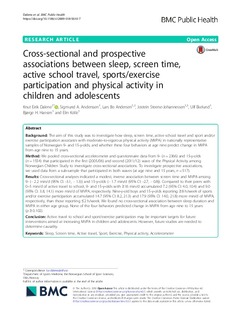| dc.contributor.author | Dalene, Knut Eirik | |
| dc.contributor.author | Anderssen, Sigmund Alfred | |
| dc.contributor.author | Andersen, Lars Bo | |
| dc.contributor.author | Steene-Johannessen, Jostein | |
| dc.contributor.author | Ekelund, Ulf | |
| dc.contributor.author | Hansen, Bjørge Hermann | |
| dc.contributor.author | Kolle, Elin | |
| dc.coverage.spatial | Norway | nb_NO |
| dc.date.accessioned | 2019-01-22T14:58:01Z | |
| dc.date.available | 2019-01-22T14:58:01Z | |
| dc.date.created | 2018-07-13T12:48:32Z | |
| dc.date.issued | 2018 | |
| dc.identifier.citation | Dalene, K. E., Anderssen, S. A., Andersen, L. B., Steene-Johannessen, J., Ekelund, U., Hansen, B. H., & Kolle, E. (2018). Cross-sectional and prospective associations between sleep, screen time, active school travel, sports/exercise participation and physical activity in children and adolescents. BMC Public Health, 18(1), 1-10. | nb_NO |
| dc.identifier.issn | 1471-2458 | |
| dc.identifier.uri | http://hdl.handle.net/11250/2581848 | |
| dc.description.abstract | Background
The aim of this study was to investigate how sleep, screen time, active school travel and sport and/or exercise participation associates with moderate-to-vigorous physical activity (MVPA) in nationally representative samples of Norwegian 9- and 15-y-olds, and whether these four behaviors at age nine predict change in MVPA from age nine to 15 years.
Method
We pooled cross-sectional accelerometer and questionnaire data from 9- (n = 2366) and 15-y-olds (n = 1554) that participated in the first (2005/06) and second (2011/12) wave of the Physical Activity among Norwegian Children Study to investigate cross-sectional associations. To investigate prospective associations, we used data from a sub-sample that participated in both waves (at age nine and 15 years, n = 517).
Results
Cross-sectional analyses indicated a modest, inverse association between screen time and MVPA among 9- (− 2.2 min/d (95% CI: -3.1, − 1.3)) and 15-y-olds (− 1.7 min/d (95% CI: -2.7, − 0.8)). Compared to their peers with 0–5 min/d of active travel to school, 9- and 15-y-olds with ≥16 min/d accumulated 7.2 (95% CI: 4.0, 10.4) and 9.0 (95% CI: 3.8, 14.1) more min/d of MVPA, respectively. Nine-y-old boys and 15-y-olds reporting ≥8 h/week of sports and/or exercise participation accumulated 14.7 (95% CI: 8.2, 21.3) and 17.9 (95% CI: 14.0, 21.8) more min/d of MVPA, respectively, than those reporting ≤2 h/week. We found no cross-sectional association between sleep duration and MVPA in either age group. None of the four behaviors predicted change in MVPA from age nine to 15 years (p ≥ 0.102).
Conclusion
Active travel to school and sport/exercise participation may be important targets for future interventions aimed at increasing MVPA in children and adolescents. However, future studies are needed to determine causality. | nb_NO |
| dc.language.iso | eng | nb_NO |
| dc.publisher | BioMed Central | nb_NO |
| dc.rights | Navngivelse 4.0 Internasjonal | * |
| dc.rights.uri | http://creativecommons.org/licenses/by/4.0/deed.no | * |
| dc.subject | sleep | nb_NO |
| dc.subject | screen time | nb_NO |
| dc.subject | active travel | nb_NO |
| dc.subject | sport | nb_NO |
| dc.subject | exercise | nb_NO |
| dc.subject | physical activity | nb_NO |
| dc.subject | accelerometer | nb_NO |
| dc.title | Cross-sectional and prospective associations between sleep, screen time, active school travel, sports/exercise participation and physical activity in children and adolescents | nb_NO |
| dc.type | Journal article | nb_NO |
| dc.type | Peer reviewed | nb_NO |
| dc.description.version | publishedVersion | nb_NO |
| dc.rights.holder | © The Author(s). | nb_NO |
| dc.subject.nsi | VDP::Medisinske Fag: 700::Idrettsmedisinske fag: 850 | nb_NO |
| dc.source.pagenumber | 1-10 | nb_NO |
| dc.source.volume | 18 | nb_NO |
| dc.source.journal | BMC Public Health | nb_NO |
| dc.source.issue | 1 | nb_NO |
| dc.identifier.doi | 10.1186/s12889-018-5610-7 | |
| dc.identifier.cristin | 1597117 | |
| cristin.unitcode | 203,0,0,0 | |
| cristin.unitname | Høgskulen på Vestlandet | |
| cristin.ispublished | true | |
| cristin.fulltext | original | |
| cristin.qualitycode | 1 | |

